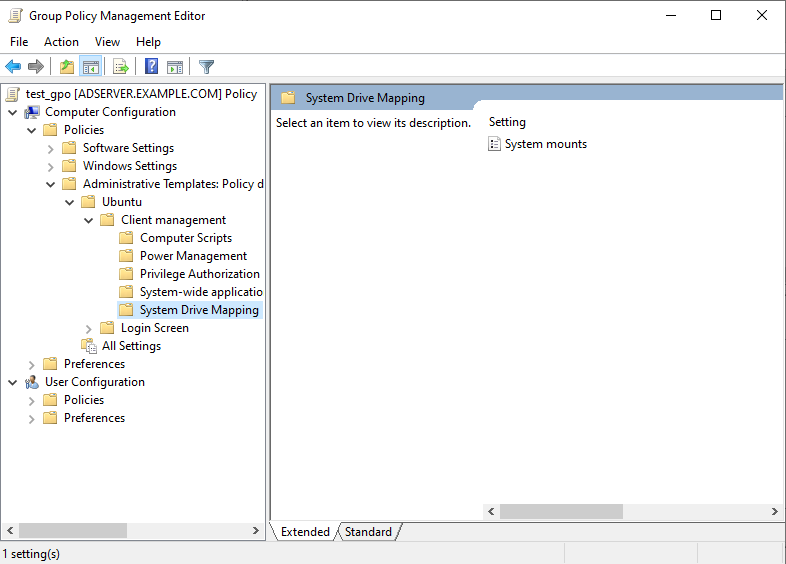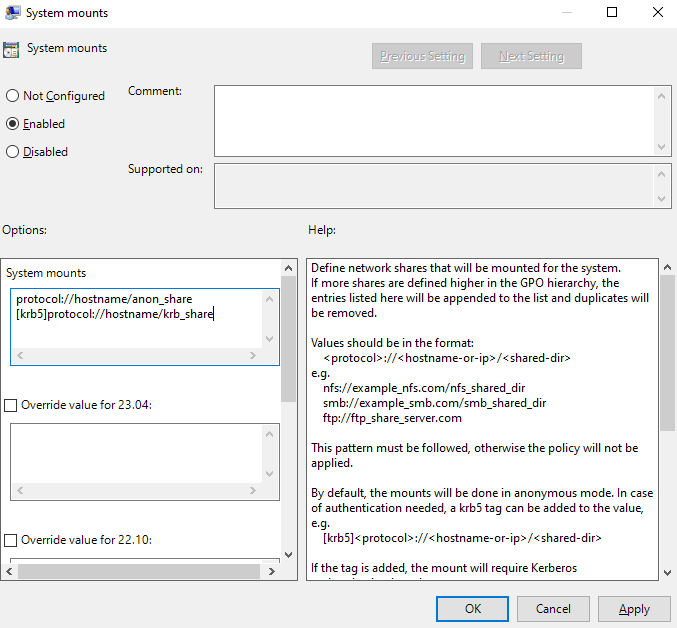Network shares¶
The mount managers allow AD administrators to specify network shares that must be mounted in the file system when a client logs in.
Feature Availability¶
This feature is available only for subscribers of Ubuntu Pro.
System mounts¶
The mount process for these mounts is triggered at the moment a client logs in. System mounts are handled by systemd through unit files and happen at root level. Therefore, users do not have control over the mounting / unmounting process.
All protocols supported by the mount command should work out of the box. However, the only tested ones are smb, ftp and nfs.
The backends for the protocols smb and nfs are automatically enabled when installing the adsys package. In order to enable the backend for ftp mounts, the user must install the recommended curlftpfs package. This behavior is tested on Ubuntu and might differ on other Linux distributions.
Access control and file permissions should be configured on the shared location.
User mount policies are located under Computer Configuration > Policies > Administrative Templates > Ubuntu > Client management > System Drive Mapping, as shown in the following picture.

Setting up the policy¶
The form is a list of shared drives that should be mounted for the client machine. They must follow the structure {protocol}://{host name or ip address}/{shared location}.
The default mount behavior is to mount the listed shares anonymously. In order to require kerberos authentication for the mount process, the tag [krb5] can be added as a prefix to the listed share, i.e. [krb5]{protocol}://{host name or ip address}/{shared location}.
Additional mount options are not supported yet.
All entries must be separated by a line break.

Rules precedence¶
The policy strategy is “append”. Therefore, if multiple policies defining network shares are to be applied to a client, all of the listed shares will be mounted.
Duplicated shares will be handled. Anonymous and authenticated shares of the same location are treated as duplicates and the first one listed will take precedence over the others.
Invalid mounts¶
ADSys will block client authentication only if the policy cannot be applied, meaning that the listed shares could not be set up. Any issues that arise after the setup process, such as an unreachable domain or a non-existent share, will be reported as an error. Refer to the system logs for more details about the failures.
Unmounting¶
The unmounting process is handled by systemd on shutdown.
User mounts¶
The mount process for these mounts is triggered at the moment a user logs in. User mounts are accessible in the file manager and the user has the ability to unmount them manually.
Credentials authentication for mounts are disabled on ADSys. Instead, authentication is done with the Kerberos ticket present on the machine. If the mount is set to anonymous, then the administrator must ensure that the shared drive supports anonymous access and that the permissions for the directory are set accordingly.
User mount policies are located under User Configuration > Policies > Administrative Templates > Ubuntu > Session management > User Drive Mapping, as shown in the following picture.

Setting up the policy¶
The format is a list of shared drives that should be mounted for the user. They must follow the structure {protocol}://{host name or ip address}/{shared location}. If the drive is to be mounted anonymously, the tag [anonymous] should be added as a prefix to the listed entry, i.e. [anonymous]{protocol}://{host name or ip address}/{shared location}.
All entries must be separated by a line break.

The mount process is handled with GVfs and it defines in which directory the shared drive will be mounted into. Usually, it’s mounted under /run/user/%U/gvfs/.
Rules precedence¶
The policy strategy is “append”. Therefore, if multiple policies defining mount locations are to be applied to a user, all of the listed entries will be mounted.
Invalid mounts¶
If the mounting of an entry listed in the policy fails, ADSys will proceed with the other entries in the policy, mounting those it can and logging those that cannot be mounted.
Unmounting¶
The unmounting process is handled by systemd at the end of the session.
